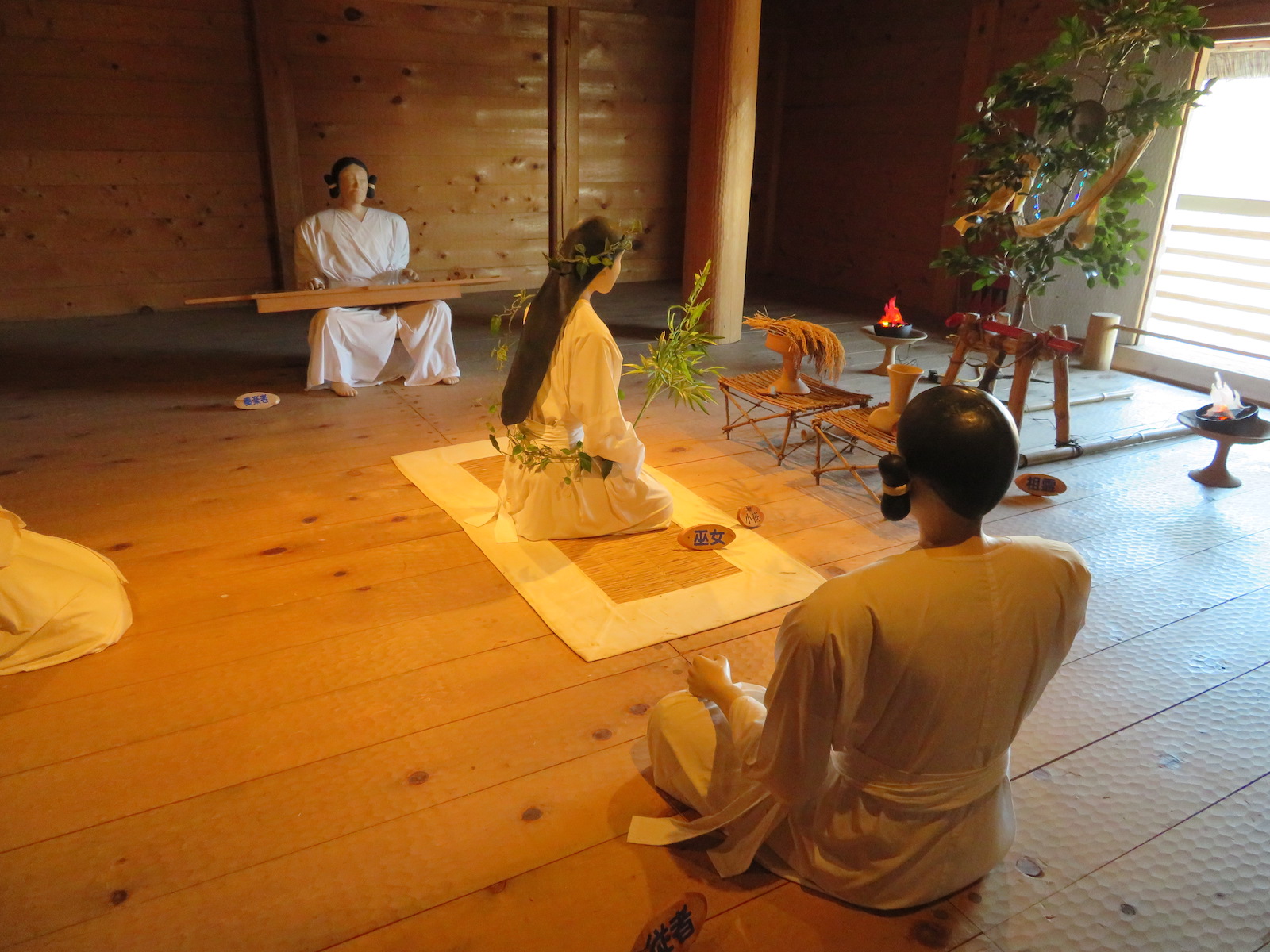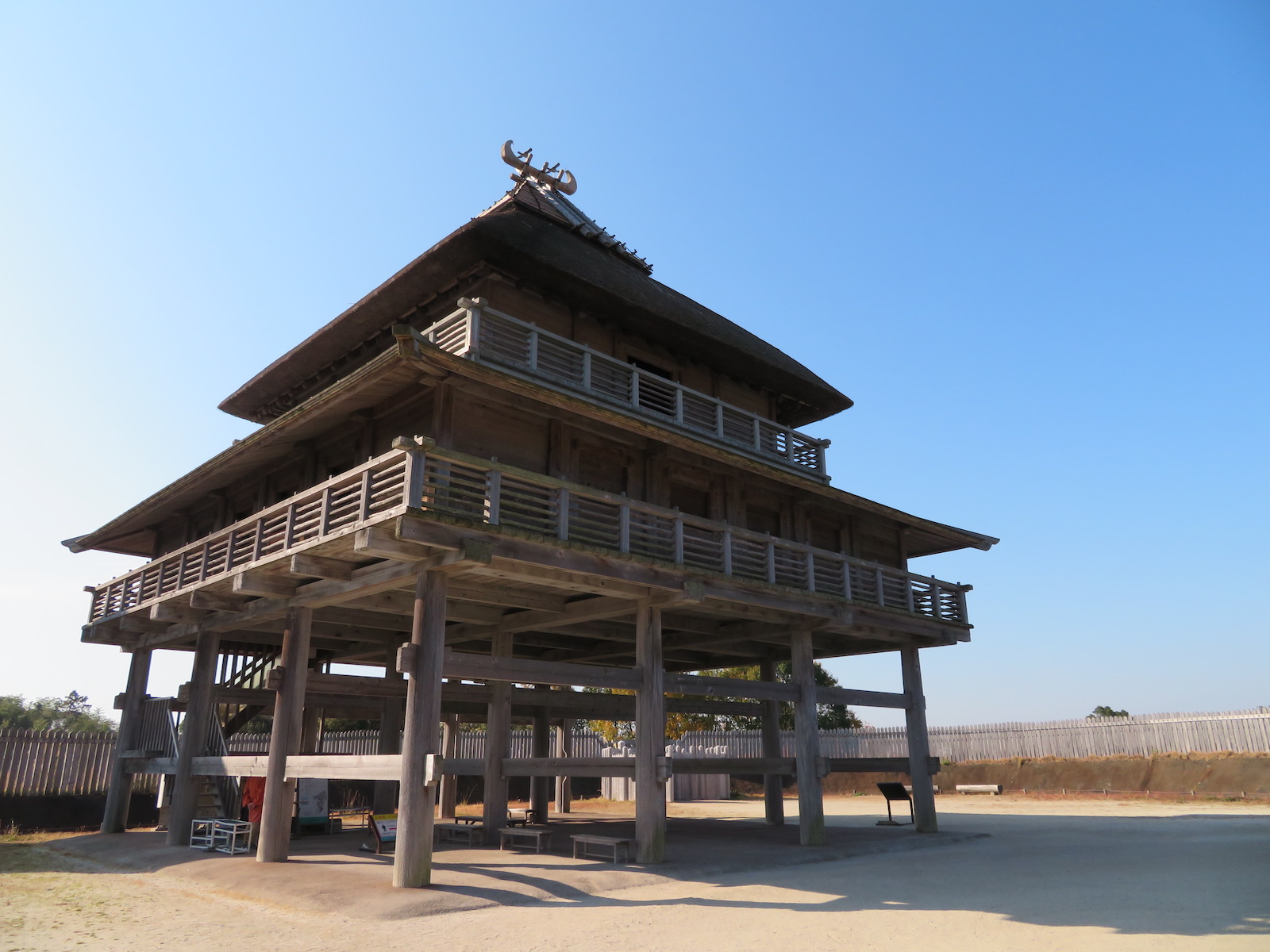In the mid-1980s, the government of Kyushu’s Saga Prefecture decided to develop a relative unused low hill in the town of Yoshinogari, about 12 kilometers from the Ariake Sea, into a regional industrial park. Shortly after preparatory earthmoving began, the bulldozer operators noticed they were digging up curious old bits of pottery and other unfamiliar detritus. The authorities soon realized they had unearthed something unusual and archaeologists were called in.
As excavations continued, it soon became obvious that the hill was the site of an ancient settlement, a palisaded community that could be dated to Japan’s Yayoi Period. Now believed to cover about 40 hectares, where excavations have been completed the Yayoi settlement has been reconstructed and is open to the public. The Yoshinogari Historical Park is a fascinating spot where ancient history comes back to life.
Before the Yoshinogari discovery, the Yayoi historical period—the time when wet rice cultivation and organized social structures are thought to have begun in Japan—was believed to cover 300 BC to 300 AD. The carbon dating of some artifacts recovered at Yoshinogari has pushed this time period back about five centuries to around 800-1,000 BC, although archaeologists are still debating the exact dating of the period.
Some of the religious structures, as tall as three stories, are visible from a distance as one approaches the park. It is amazing to think that early Iron Age peoples could have managed such elaborate constructions.

There is archaeological evidence that many Yayoi communities warred against each other and lived in settlements palisaded for defensive purposes. Yoshinogari is one such community. The entrance includes reconstructed palisades, a dry moat and a gate. It is believed that most agriculture took place outside the settled areas but, as the surrounding low areas have been continuously occupied and farmed for more than two millennia, it has been impossible to find the remains of the ancient rice paddy “walls” that are usually used to identify Yayoi remains.
From the entrance, pathways lead to various sections of the palisaded community. To the left are houses believed to have been occupied by the farming classes of society, while up the hill to the right is where the governing class lived, their section overlooked by an imposing look-out tower. A separately palisaded area contains granaries, set high above the ground with barriers to prevent rodents from getting in.

Yayoi Period houses are pit structures not unlike, although slightly more sophisticated than, the pit houses of its predecessor Jomon period (1,400 to 300 BC). For a long time, scholars believed the Jomon people were supplanted by Yayoi migrants from Korea, China and parts of Southeast Asia, although more recent scholarship, including DNA from ancient bones, has led to the theory that the hunter-gatherer Jomon people were largely absorbed into the agrarian Yayoi populations so that modern Japanese are descended from both.
The floor of the houses was dug a roughly a meter into the ground. A slanting pole structure was built over the pit and thatched to give a tent-like appearance. The only light is from the single door. A fire kept constantly burning in the center ensured that the floor stayed dry. Platforms for sleeping and tool storage are on the perimeter of the pit.

Larger homes show separations within the homes for different uses, including storage, sleeping, cooking, and eating. In addition to settled agricultural, the Yayoi people engaged in basic metallurgy and weaving and used relatively sophisticated tools incorporate both stone and iron.
The Yayoi are believed to have worn both tanned leather and dyed woven cloth garments. Like their Jomon predecessors, they made substantial use of pottery.
In one area there are pit houses for the chieftain and multiple wives, all behind a subdivided area.

In another section of the settlement, nearer to the highest point of the hill, stands a subdivision given over to religious observation, dominated by the tower/temple that was visible from a distance. On the upper floors, visitors can see different reconstructed rituals, many thought to have been influenced by shamanistic beliefs that the Yayoi brought with them from Korea.

While the Japanese have no contemporary written history of their own (Japan’s first written history was compiled in the sixth century AD), there are Chinese records of Sino-Japanese encounters of this time period which provide information on various aspects of Yayoi society that archaeologists can now corroborate with the archaeological record.

Beyond the religious subdivision lies the cemetery, a hillock of tufts that turn out to be the graves. The Yayoi preferred to bury their dead in terra cotta coffins comprised of two massive jars.

Replicas have been situated around the tufts to help visitors see how burials worked. Nearby an air-conditioned building has been built over one excavation, permitting visitors to see even more of the relatively sophisticated burial practices of these prehistoric people. Videos and other visual displays also provide additional insights.

This point is the farthest from the park entrance and a small shuttle bus passes from time to time to offer foot-weary visitors a bit of a respite as it carries them to the museum of artifacts situated closer to the gate.
The museum contains weapons, tools and potsherds as well as exhibitions on weaving and other “industrial” activities of the period. There are also mirrors made of polished bronze, a significant feature in religious life and, apparently, a symbol of wealth and power. This type of mirror was first introduced from China; Chinese-made mirrors as well as their Japanese counterparts have been unearthed at Yoshinogari.
Yoshinogari Historical Park is an interesting intellectual exercise for adults, but equally fascinating and fun for children. During summer, the park offers some participatory activities such as lessons in fire-making and making glass beads that are especially fun for children.
The park is open daily from 9:00 to 5 p.m. (6 p.m. from June 1 to August 31). It is closed only on December 31 and the third Monday and Tuesday of January. Admission is 460 yen for adults; children under 15 are free of charge.
Vicki L Beyer, a regular Japan Today contributor, is a freelance travel writer who also blogs about experiencing Japan. Follow her blog at jigsaw-japan.com.
© Japan Today Take our user survey and make your voice heard.
Take our user survey and make your voice heard.















3 Comments
Login to comment
BackpackingNepal
Aren't there real Yayoi? I've watched their movie 1985 Seburi Monogatari, they are different than the Japanese.